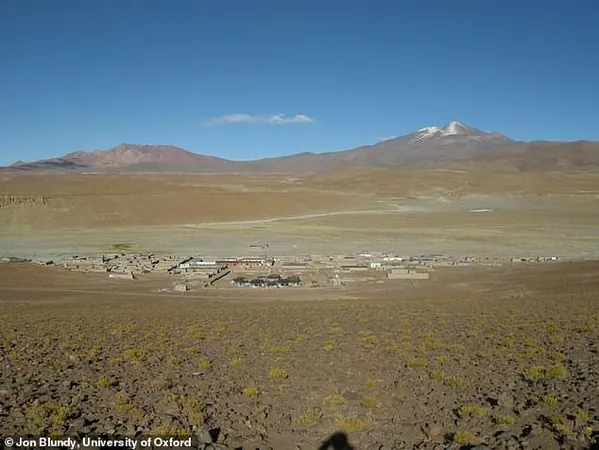
The ‘Zombie’ Volcano Returns: Uturuncu’s Potential Eruption Raises Alarms
2025-05-04
Author: Rajesh
In a startling turn of events, the ‘zombie’ volcano Uturuncu, which has lain dormant for an astonishing 250,000 years, is stirring, raising fears of a potentially catastrophic eruption.
Nestled in the breathtaking Andes Mountains of Bolivia, Uturuncu has recently exhibited alarming seismic activity and gas emissions, leading scientists to believe that an eruption could be just around the corner.
Evidence of this volcanic unrest is apparent in a unique 'sombrero' pattern of ground deformation. As the core of the volcano rises, the surrounding land sinks—signs that something beneath the surface is changing.
A dedicated team of researchers from the University of Oxford has linked this activity to the movement of magma and gas lurking beneath the crater, which is situated above the largest known magma reservoir in the Earth's crust.
Standing at a formidable height of over 19,700 feet, Uturuncu is a stratovolcano, characterized by its steep, cone-like shape developed from layers of hardened lava, ash, and rock. The infamous Mount St. Helens and the historic Mount Vesuvius, both known for their destructive eruptions, share this classification.
Uturuncu poses a grave threat, as it lies merely 25 miles from three towns. Should it erupt, nearby communities could be engulfed by lava flows, and volcanic ash could spread across Bolivia, Argentina, and Chile—a disaster in the making.
Scientists have recorded over 1,700 earthquakes around the volcano in recent weeks, igniting curiosity about how such a long-dormant volcano could come back to life. Using seismic tomography, akin to medical imaging, researchers have generated detailed 3D visuals of Uturuncu’s insides.
This innovative technique enabled them to analyze how seismic waves interact with different materials, revealing possible conduits for hot fluids and gaseous build-ups beneath the crater, which could be responsible for the rising ground.
While the chances of a full-blown eruption are currently deemed low, co-author Professor Matthew Pritchard believes that the methodologies they are developing can be applied to over 1,400 other potentially active volcanoes worldwide—many of which, like Uturuncu, show signs of life after years of dormancy.
Examples of such 'zombie' volcanoes include California's Long Valley Caldera and Yellowstone, which last erupted around 70,000 years ago. Though scientists remain vigilant, there is also growing concern over Mount Spurr in Alaska, which has recently shown signs indicating a possible eruption in the coming months. Alaskan officials are on high alert due to increased seismic activity.
Should Mount Spurr erupt, the consequences could be dire. A massive ash cloud rising up to 50,000 feet would force the closure of major airports, wreaking havoc on air travel and disrupting international supply chains.
Following its last eruption in 1992, Mount Spurr caused significant disruption at Anchorage’s Ted Stevens International Airport, darkening daytime skies and coating the area in ash.
Flying through volcanic ash poses severe risks, as particles can damage aircraft engines and critical systems. Thus, the impending threat of eruptions around the world continues to demand our attention and preparedness.



 Brasil (PT)
Brasil (PT)
 Canada (EN)
Canada (EN)
 Chile (ES)
Chile (ES)
 Česko (CS)
Česko (CS)
 대한민국 (KO)
대한민국 (KO)
 España (ES)
España (ES)
 France (FR)
France (FR)
 Hong Kong (EN)
Hong Kong (EN)
 Italia (IT)
Italia (IT)
 日本 (JA)
日本 (JA)
 Magyarország (HU)
Magyarország (HU)
 Norge (NO)
Norge (NO)
 Polska (PL)
Polska (PL)
 Schweiz (DE)
Schweiz (DE)
 Singapore (EN)
Singapore (EN)
 Sverige (SV)
Sverige (SV)
 Suomi (FI)
Suomi (FI)
 Türkiye (TR)
Türkiye (TR)
 الإمارات العربية المتحدة (AR)
الإمارات العربية المتحدة (AR)